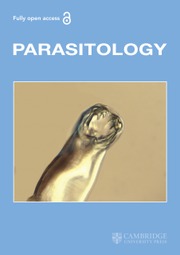Crossref Citations
This article has been cited by the following publications. This list is generated based on data provided by
Crossref.
Desai, Sanjay A.
and
Miller, Louis H.
2014.
Protein-export pathway illuminated.
Nature,
Vol. 511,
Issue. 7511,
p.
541.
Young, Ryan
and
Pesce, Eva-Rachele
2015.
Marine Biomedicine.
p.
183.
Njunge, James M.
Mandal, Pradipta
Przyborski, Jude M.
Boshoff, Aileen
Pesce, Eva-Rachele
and
Blatch, Gregory L.
2015.
PFB0595w is a Plasmodium falciparum J protein that co-localizes with PfHsp70-1 and can stimulate its in vitro ATP hydrolysis activity.
The International Journal of Biochemistry & Cell Biology,
Vol. 62,
Issue. ,
p.
47.
Daniyan, Michael O.
Boshoff, Aileen
Prinsloo, Earl
Pesce, Eva-Rachele
Blatch, Gregory L.
and
Kampinga, Harm H
2016.
The Malarial Exported PFA0660w Is an Hsp40 Co-Chaperone of PfHsp70-x.
PLOS ONE,
Vol. 11,
Issue. 2,
p.
e0148517.
Gonçalves, Conrado C.
and
Ramos, Carlos H. I.
2016.
Heat Shock Proteins and Plants.
Vol. 10,
Issue. ,
p.
245.
Lo Presti, Libera
López Díaz, Cristina
Turrà, David
Di Pietro, Antonio
Hampel, Martin
Heimel, Kai
and
Kahmann, Regine
2016.
A conserved co‐chaperone is required for virulence in fungal plant pathogens.
New Phytologist,
Vol. 209,
Issue. 3,
p.
1135.
Cabral, Fernanda J
Vianna, Luciana G
Medeiros, Marcia M
Carlos, Bianca Cechetto
Martha, Rosimeire D
Silva, Nadia Maria
Silva, Luiz Hildebrando P da
Stabeli, Rodrigo G
and
Wunderlich, Gerhard
2017.
Immunoproteomics of Plasmodium falciparum-infected red blood cell membrane fractions.
Memórias do Instituto Oswaldo Cruz,
Vol. 112,
Issue. 12,
p.
850.
Saarikangas, Juha
and
Caudron, Fabrice
2017.
Spatial regulation of coalesced protein assemblies: Lessons from yeast to diseases.
Prion,
Vol. 11,
Issue. 3,
p.
162.
Batista, Fernanda A.H.
Dores-Silva, Paulo R.
and
Borges, Júlio C.
2018.
Molecular Chaperones Involved in Protein Recovery from Aggregates are Present in Protozoa Causative of Malaria andLeishmaniasis.
Current Proteomics,
Vol. 16,
Issue. 1,
p.
12.
Pan, Junjiang
Cao, Ding
and
Gong, Jianping
2018.
The Endoplasmic Reticulum Co-Chaperone ERdj3/DNAJB11 Promotes Hepatocellular Carcinoma Progression through Suppressing AATZ Degradation.
Future Oncology,
Vol. 14,
Issue. 29,
p.
3001.
Kang, Rui
and
Tang, Daolin
2019.
Ferroptosis in Health and Disease.
p.
61.
Daniyan, Michael O.
Przyborski, Jude M.
and
Shonhai, Addmore
2019.
Partners in Mischief: Functional Networks of Heat Shock Proteins of Plasmodium falciparum and Their Influence on Parasite Virulence.
Biomolecules,
Vol. 9,
Issue. 7,
p.
295.
Grijalva-Mañay, Rosita
Dorca-Fornell, Carmen
Enríquez-Villacreses, Wladimir
Miño-Castro, Gabriela
Oliva, Ricardo
Ochoa, Valeria
Proaño-Tuma, Karina
and
Armijos-Jaramillo, Vinicio
2019.
DnaJ molecules as potential effectors in Meloidogyne arenaria. An unexplored group of proteins in plant parasitic nematodes.
Communicative & Integrative Biology,
Vol. 12,
Issue. 1,
p.
151.
Day, Jemma
Passecker, Armin
Beck, Hans‐Peter
and
Vakonakis, Ioannis
2019.
The Plasmodium falciparum Hsp70‐x chaperone assists the heat stress response of the malaria parasite.
The FASEB Journal,
Vol. 33,
Issue. 12,
p.
14611.
Anas, Mohammad
Shukla, Ankita
Tripathi, Aradhya
Kumari, Varsha
Prakash, Chetan
Nag, Priyabrata
Kumar, L. Sathish
Sharma, Sandeep K.
Ramachandran, Ravishankar
and
Kumar, Niti
2020.
Structural–functional diversity of malaria parasite's PfHSP70-1 and PfHSP40 chaperone pair gives an edge over human orthologs in chaperone-assisted protein folding.
Biochemical Journal,
Vol. 477,
Issue. 18,
p.
3625.
Matz, Joachim M.
Beck, Josh R.
and
Blackman, Michael J.
2020.
The parasitophorous vacuole of the blood-stage malaria parasite.
Nature Reviews Microbiology,
Vol. 18,
Issue. 7,
p.
379.
Dutta, Tanima
Singh, Harpreet
Gestwicki, Jason E.
and
Blatch, Gregory L.
2021.
Exported plasmodial J domain protein, PFE0055c, and PfHsp70-x form a specific co-chaperone-chaperone partnership.
Cell Stress and Chaperones,
Vol. 26,
Issue. 2,
p.
355.
Daniyan, Michael Oluwatoyin
2021.
Heat Shock Proteins of Malaria.
Vol. 1340,
Issue. ,
p.
205.
Dutta, Tanima
Pesce, Eva-Rachele
Maier, Alexander G.
and
Blatch, Gregory L.
2021.
Heat Shock Proteins of Malaria.
Vol. 1340,
Issue. ,
p.
97.
Edkins, Adrienne Lesley
and
Boshoff, Aileen
2021.
Heat Shock Proteins of Malaria.
Vol. 1340,
Issue. ,
p.
11.



